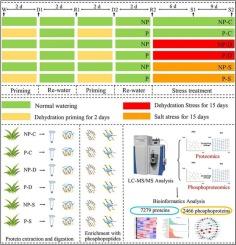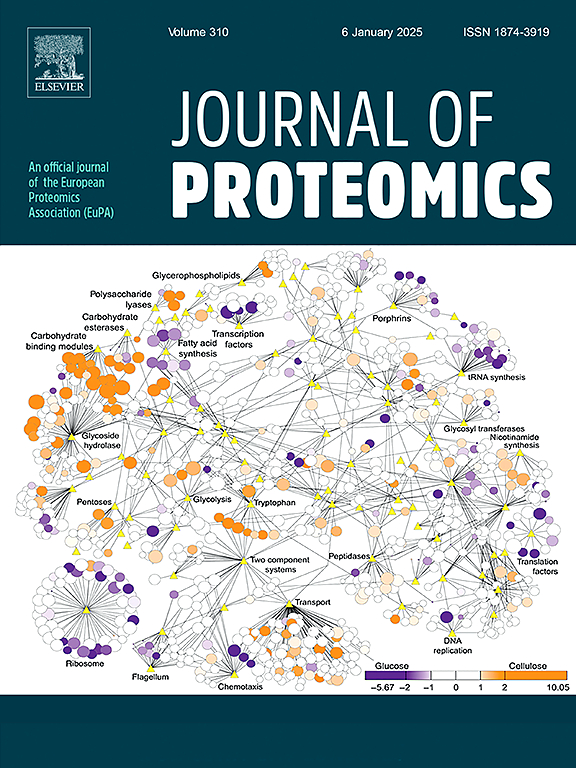脱水启动可重塑蛋白质丰度和磷酸化水平,从而调节匍匐翦股颖对后续脱水或盐胁迫的耐受性。
IF 2.8
2区 生物学
Q2 BIOCHEMICAL RESEARCH METHODS
引用次数: 0
摘要
脱水诱导(DP)可诱导胁迫记忆,对植物的适应性起积极作用,但目前还不太清楚脱水诱导如何在翻译后水平上对随后的脱水(顺式诱导)或耐盐(反式诱导)进行差异调控。本研究的目的是鉴定 Agrostis stolonifera 中 DP 诱导的脱水或耐盐性的蛋白质、磷酸化水平和位点以及相关代谢途径。DP诱导的差异调控蛋白(DEPs)主要位于细胞质、叶绿体和细胞膜,差异调控磷酸化蛋白(DRPPs)主要是核蛋白和细胞质蛋白。在脱水和盐胁迫条件下,DP调控共同的磷酸化位点([SP]和[RxxS]),在脱水或盐胁迫条件下,DP还单独影响8或11个磷酸化位点。在脱水胁迫下,DP调控的DRPPs主要富集于糖酵解和谷胱甘肽代谢途径、RNA剪接和dynamin家族蛋白;而在磷酸化水平上,DP调控的耐盐性主要与叶绿素代谢、光合作用、MAPK信号级联和ABC转运体I家族有关。此外,DP还能显著上调组蛋白(ATXR3和SETD1A)的磷酸化水平,以应对随后的脱水和盐胁迫;在脱水胁迫下,还能显著上调抗氧化酶、dynamin家族蛋白和KCS6的丰度;在盐胁迫下,还能显著上调PETE、HMGA、XTH和ABCI6的丰度。转录组学分析还进一步表明,DP调控的脱水或耐盐性在早期阶段也与转录调控有关。目前的研究结果使人们更好地理解了胁迫记忆通过翻译后修饰(PTMs)在植物适应重复或交叉胁迫中的作用。意义:反复出现的中度干旱可能会缓冲许多植物物种的干旱遗产。当植物受到反复干旱胁迫时,它们对后续胁迫的适应性会增强,这就是所谓的 "胁迫记忆"。脱水引物被认为是诱导胁迫记忆的一种重要方法。目前的研究结果让人们更好地了解了胁迫记忆通过翻译后修饰在植物适应重复或交叉胁迫中的作用。本文章由计算机程序翻译,如有差异,请以英文原文为准。

Dehydration priming remodels protein abundance and phosphorylation level regulating tolerance to subsequent dehydration or salt stress in creeping bentgrass
Dehydration priming (DP) induces stress memory which plays a positive role in plant adaptability, but it is not well understood how DP differentially regulates subsequent dehydration (cis priming) or salt (trans priming) tolerance at the post-translational level. Purpose of this study was to identify proteins, phosphorylation levels and sites, and relevant metabolic pathways for DP-induced dehydration or salt tolerance in Agrostis stolonifera. DP-induced differentially regulated proteins (DRPs) were mostly located in the cytoplasm, chloroplast, and cell membrane, and differentially regulated phosphoproteins (DRPPs) were mostly nuclear proteins and cytoplasmic proteins. DP regulated common phosphorylation sites ([SP] and [RxxS]) under dehydration and salt conditions and also individually affected 8 or 11 phosphorylation sites under dehydration or salt stress. DP-regulated DRPPs were mainly rich in glycolysis and glutathione metabolism pathways, RNA splicing, and dynamin family proteins under dehydration stress, whereas DP-regulated salt tolerance was mainly related to chlorophyll metabolism, photosynthesis, MAPK signaling cascade, and ABC transporter I family at the phosphorylation level. In addition, the DP also significantly up-regulated phosphorylation of histones (ATXR3 and SETD1A) in response to subsequent dehydration and salt stress as well as abundances of antioxidant enzymes, dynamin family protein, and KCS6 under dehydration stress or abundances of PETE, HMGA, XTH, and ABCI6 under salt stress, respectively. Transcriptomics analysis further indicated that DP-regulated dehydration or salt tolerance was also related to transcriptional regulation in the early stage. Current results provided better understanding of the role of stress memory in plant adaptability to repeated or crossed stress via post-translational modifications (PTMs).
Significance
Recurrent moderate drought may buffer drought legacies in many plant species. When plants were exposed to repeated drought stress, their adaptability to subsequent stress could be enhanced, which is known as “stress memory”. Dehydration priming has been found to be an important approach to induce stress memory. Current results provided better understanding of the role of stress memory in plant adaptability to repeated or crossed stress via post-translational modifications.
求助全文
通过发布文献求助,成功后即可免费获取论文全文。
去求助
来源期刊

Journal of proteomics
生物-生化研究方法
CiteScore
7.10
自引率
3.00%
发文量
227
审稿时长
73 days
期刊介绍:
Journal of Proteomics is aimed at protein scientists and analytical chemists in the field of proteomics, biomarker discovery, protein analytics, plant proteomics, microbial and animal proteomics, human studies, tissue imaging by mass spectrometry, non-conventional and non-model organism proteomics, and protein bioinformatics. The journal welcomes papers in new and upcoming areas such as metabolomics, genomics, systems biology, toxicogenomics, pharmacoproteomics.
Journal of Proteomics unifies both fundamental scientists and clinicians, and includes translational research. Suggestions for reviews, webinars and thematic issues are welcome.
 求助内容:
求助内容: 应助结果提醒方式:
应助结果提醒方式:


